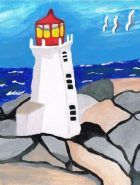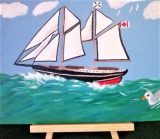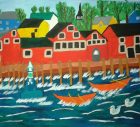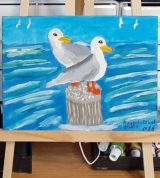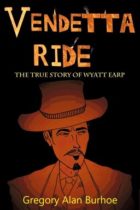Canadian Mounties ride West.
Canada and Mexico.

CANADA and MEXICO: Canadian Mounties, Scottish Influence & American Traders
One of the overlooked aspects of the Creation of our Dominion of Canada is its multi-national beginnings. Especially its strong Scottish ties.
The American concept of “Law and Order” has only appeared recently in our Dominion’s discourse. When Scotsman John A Macdonald was actively battling for the creation of “a new independent Dominion under God” called Canada in 1867, he used the Scottish phrase “Law and Justice!” He also used “Law and Justice” six years later when establishing the North-West Mounted Police Force.
I guess Canadian pronunciation is often Scottish. “Aboot” for “About” for instance. Our Friends to the South tease us about them. Though WE can’t hear the difference, eh?
More important to your average whisky-drinking Canadian is our Scottish spelling of “whisky,” opposed to the Irish “whiskey” used in the US.
Here, from Scottish writer John Walker, are some thoughts on the matter. Quoted from the University of Edinburgh Journal. [1]
“The Scots Influence in the Royal Canadian Mounties” by John Walker
Scottish traditions and influences run deep in the psyche and landscape of
Canada.
Those influences are evident in the much loved and internationally respected Royal Canadian Mounted Police. Who were commonly known as the RCMP, or informally the “Mounties.” And as “The Force” internally.
Tension on the Canadian Prairies and Scots Influence
Four Scots are central to the creation, safeguarding and success of the Confederation of Canada:
- Sir John A Macdonald, born in Glasgow in 1815, a Founding Father and the first Prime Minister of Canada
- Colonel Patrick Robertson-Ross, born in Edinburgh, Adjunct General of the Canadian Militia
- Major James Farquharson Macleod, born in Drynoch, Isle of Skye, Assistant Commissioner of the North-West Mounted Police
- Jerry Potts, Canadian Mounties guide and interpreter, born in Canada of a Scottish father, who was a fur trader, and a Blood Indian mother.
American Whisky Traders, the Canadian West and the Annexation Dream
American whisky traders, who were also provocatively selling repeating rifles to the natives, were crossing the 49th Parallel from Montana. They peddled their “firewater” out of fortified posts. The biggest was called Fort Whoop-Up, a place of “drunken debauchery, fraud and cruelty.” [2]
Those Whisky Forts were manned by some of the most brutally dangerous men across the Frontier. Not only American and Canadian, but some Métis, Russian-Alaskans and even Mexican banditos. They thrived in that unpoliced land. For many, it was their last resort. [3]
Alarm was raised about two issues. Border sovereignty, in a time of hyperactive American “Manifest Destiny.” And the risk of outright war with the indigenous people. Combined with the deleterious effects of whisky trading that was having a disastrous effect on those Native People.
In 1872, Colonel Patrick Robertson-Ross was sent out on a fact-finding mission to the Canadian Northwest. He found that the “Whisky Trade” was endangering the very existence of the Plains Tribes. Especially the Blackfoot Confederacy. And seeing the number of American flags already flying on the fortified trading posts, concluded that the talk in Washington of “annexing Canada” was a reality.

Robertson-Ross recommended “that a cavalry regiment of 550 riflemen be organized to preserve order in the territory. And wear British Scarlet uniforms to starkly distinguish them from the blue-coated American soldiers whom the plains Indians fear and despise.”
The Final Straw: The Cypress Hills Massacre
News was received in the Canadian parliament in Ottawa in 1873 that a massacre of Assiniboine men, women and children had taken place at Cypress Hills. The killings had been committed by American wolf hunters who were on their way back to Montana through northwestern Canada.
Clearly, parliamentary action was required. And an Act was finally passed in May 1873. It was driven by the prone-to-procrastination Prime Minister, Sir John A MacDonald. MacDonald who had a deep concern of the need to populate the Canadian prairies. He wanted to keep the territory within Canada and maintain a transcontinental nation. Scarred by the Red River rebellion among the Métis in 1869-70, he couldn’t afford to have another native uprising.
The Formation of the Canadian Mounties: our North-West Mounted Police (NWMP)
MacDonald had sufficient parliamentary influence to establish a new military force. One with policing powers and Justice of the Peace status. It would march West and establish authority. Protect and build good relationships with the native people. As well as punish the guilty, deal with the illegal whisky trading and bring law and justice to the territory.
Recruitment took place. By 1874 a force of 275 officers and troops formed into six divisions assembled in Dufferin, Manitoba. They were ready to make the 1200-mile trek westward in what was to become known as the Great March West.
Their contingent included 114 Red River carts, 73 wagons, and two field guns. It was led by James Farquharson Macleod. The columns would head south-west for Fort Whoop Up. The trading post known as the centre of the pernicious whisky trade, gun running, border incursions and general lawlessness in Southern Alberta.
The Great March West
Problems began almost immediately. After a grand brass band celebration in front of politicians and locals, the brightly uniformed command struck out across the prairies.
Within days they discovered that their bay horses were completely unsuited for the terrain. Those mounts had been selected for parade ground appearance, rather than the unforgiving prairie territory and indigestible grass forage. Their horses began to die in scores.

It was almost a disaster from the beginning. It was recommended, but over-ridden, that they should have had the tough western mustang horses who were adapted to a prairie diet. The uniforms, red serge tunics, dark blue trousers and pith helmets were also unsuitable in the ferocious prairie summer heat.
The route chosen by the government to reinforce sovereignty took them close to the US Canadian border. This extended the distance to travel and creating its own problems. Lack of drinkable water became acute.
Slowly and painfully, the columns made their way across the prairies to Fort Whoop Up. The men often had to walk and support their horses by putting covers on them to protect them from the heat. And sleeping beside them in the cold nights,
Finally they reached the beginning of their objective. After resting up and looking after both the men and horses they were ready to undertake their mandate. Which they did with tenacity, vigour and determination.
The fledgling Force was ably led by Superintendent James Macleod. And guided by the influential, somewhat dangerous and highly intelligent Jerry Potts. Potts was a legendary half Scots/half Indian. His extensive knowledge of the territory, native tribes and languages was absolutely crucial to the success of the expedition.
CANADA and MEXICO: Canadian Mounties, Scottish Influence & American Traders
Managing Sitting Bull
By the 1880’s the entire area was transformed. Stability had been achieved. This included managing Chief Sitting Bull of the Lakota Sioux. Sitting Bull had recently come across the border following the Battle of Little Bighorn, seeking refuge.
Sitting Bull and 5000 Sioux were met at the Medicine Line (Canadian-US Border) by only three Canadian Mounties — Superintendent James Walsh, a Constable and a Police Scout. Much to the Sioux warriors’ amazement and admiration.

It’s reported that many of his warriors still had US cavalrymen scalps visible on their horses. To the Sioux, Canada was known as “the Grandmother’s Land” — The land of Queen Victoria.
In Ottawa there was considerable concern about Sitting Bull’s presence in Canada. Under the leadership of Superintendent MacLeod and with the essential services of the interpreter Jerry Potts, danger was averted and they settled.
At first the Sioux and their families numbered in the thousands. They were able to feed themselves until the buffalo, having been systematically wiped out, suddenly disappeared. Through the late 1870s, each Spring the Great Northern Herd of bison returning to Canada had been smaller.
Gradually, many of the “Sioux Refugees” filtered back into Montana, surrendering. Sitting Bull gave up his dream of independence and asked the Canadian government for rations. In 1881, five years after the battle of Little Bighorn, Sitting Bull reluctantly returned to the US. Where he became a victim of the dreadful reservation system.
The Scarlet Riders
The March West, with its critically important Scottish influence, is at the very heart of the history and traditions of our Canadian Mounties. It’s taught at the acclaimed RCMP Depot Training Centre in Regina. It was re-enacted in 1998, celebrating the 125th anniversary of the March West and the founding of the Force.

And in 1998 the RCMP tartan was presented by HRH The Princess Royal (Princess Anne) during a visit to Atlantic Canada. The tartan is officially registered with the Scottish Tartans Society.
CANADA and MEXICO: Canadian Mounties, Scottish Influence & American Traders
[1] Excerpted in part from the University of Edinburgh Journal 47: 3 (June 2016), article by John Walker. Additional edited material added April 2, 2025.
“I had gone to Canada as a tradesman when a young man. And was now back in Edinburgh after many years’ research and teaching experience with the Royal Canadian Mounted Police. I had been attached to RCMP Fairmont Academy in Vancouver. And the Canadian Police College in Ottawa.” Author John Walker
To see John’s complete and unabridged article, go to The Scots Influence in the Royal Canadian Mounted Police
[2] The biggest lawless trading post was called Fort Whoop-Up, a place of “drunken debauchery, fraud and cruelty…” SEE CANADIAN MOUNTIES: Creation & History Royal Mounted Police – Annex Canada
For look at American Tariffs and Annexing Canada in History, SEE CANUCK MOVIES: Mounties, Nell Shipman & the Canadian Spirit — A Patriot’s Rant
[3] Mexican bandidos in the Canadian West were usually desperados who were wanted both in Mexico and Texas. Often being sought by fellow bandits they had fallen out with. “The Mexican outlaws in Canadian western winters were a mean, miserable lot.”
FURTHER READING:
THE MARCHING CALL by Harwood Steele. The biography of Sam Steele, the “Greatest Mountie.” The book covers the first twelve years of Sam’s adventurous career in the Mounted Police.
THE GREAT ADVENTURE. Selections from the Diaries, Letters & First-Hand Accounts of the Original NWMP. Collected by David Cruise & Alison Griffiths.
SITTING BULL’S BOSS: Above the Medicine Line with James Morrow Walsh by Ian Anderson. The story of the incredible friendship of a Sioux War Chief and a Mountie.

TAGS: American Tariffs, annex Canada, annexing Canada, Trump Tariffs, Trump Tariffs Canada, Mexican bandidos in the Canadian West, Canadian Mounties.



